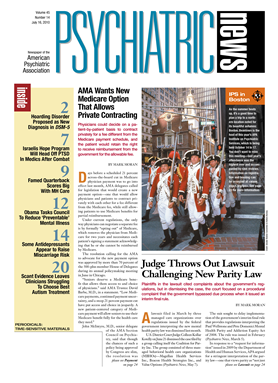“Acute electroconvulsive therapy is the most effective treatment for an acute melancholic episode, but it is also the most controversial,” said Mustafa Husain, M.D., at APA's annual meeting in New Orleans in May.
Husain and other speakers at the meeting were members of APA's Task Force to Revise the Practice of Electroconvulsive Therapy, now reviewing key clinical and procedural aspects of electroconvulsive therapy (ECT).
The controversial element still surrounding ECT means that clinicians must pay particularly close attention to the consent process at every step.
“Obtain informed consent prior to an acute course of ECT and also before beginning maintenance therapy,” advised Husain, a professor of psychiatry and internal medicine at the University of Texas Southwestern Medical Center in Dallas.
Consent should be obtained by not only the treating psychiatrist, but also by the patient's attending physician and any other clinicians involved, such as anesthesiologists, Husain emphasized.
The consent form should describe the rationale for ECT treatment and note alternative treatment possibilities, he said. The success rate for ECT is about 80 percent, but that means it does not work for 20 percent of patients, and there is a high relapse rate, “so there are no guarantees,” and this should be conveyed to patients and their families.
Having a psychiatric disorder does not, of course, automatically mean that a patient is incompetent to provide consent to ECT treatment, he noted, as long it is clear that he or she understands the risks and benefits of the procedure.
However, many states have laws stating that anyone who has been involuntarily hospitalized cannot give informed consent for ECT treatment, he cautioned.
The risks and side effects that patients should understand may follow ECT treatment include headaches, cardiopulmonary dysfunction, memory problems, or confusion. These should be explained in the informed-consent process.
“There are profound long-term memory problems in a subgroup of patients, but that must be compared with the suffering and memory problems that accompany chronic depression,” said Husain.
It is also important that patients understand that consent to treatment is voluntary and that they can withdraw it at any time. “If consent is withdrawn,” Husain said, “stop treatment but inform the patient of the consequences.”
Patients with comorbid medical conditions are often good candidates for ECT, given its rapid action and relative safety, Husain said. There are no absolute contraindications to providing ECT, but some conditions carry added risk. These include unstable angina, recent heart attack or ischemic stroke, cardiac arrhythmias, and poorly compensated congestive heart failure.
Clinical Issues to Consider With ECT
ECT outcomes are affected not only by the strength of the electrical charge applied but also by electrode placement, said Sarah Lisanby, M.D., a professor of psychiatry at Columbia University and chair of the APA ECT task force.
“Electrode placement affects distribution of the electric current, seizure topography, and treatment effects on regional brain activity,” she said.
Individual patients vary in the dose needed to trigger seizures, so it is necessary to titrate dosage in the initial session and adjust, if needed, for subsequent treatments. Placement is as important as dose is in this process.
“Without titration, right unilateral placement may be insufficiently dosed, leading to inferior clinical outcomes,” she pointed out. “Or bilateral placement may be given at an overly high dose, which may cause greater side effects.”
For instance, bilateral placement appears to produce a faster response but may result in greater memory loss, compared with right unilateral placement, she said.
Thus it is critical to individualize dosage for each patient and discuss electrode placement in advance as part of the informed-consent process, she said.
APA Addressed Issue Several Times
APA issued its first report on ECT in 1978, concentrating on a review of efficacy and safety, but discussing little about practice, said Richard Weiner, M.D., Ph.D. a professor of psychiatry at Duke University School of Medicine. Weiner edited the most recent APA guidelines on ECT, issued in 2001.
A 1985 consensus conference at the National Institute of Mental Health focused on standardizing and optimizing practice and offered recommendations on who should perform ECT, what training was needed, and how best to use it. The conference led APA to issue revised guidelines in 1990. APA updated those standards in 2001; the new guidelines are due out in 2011.
ECT's place in the regulatory spectrum has been under review for an unusually long time, said Weiner. Legislation governing medical devices passed in 1976 permitted ECT use without requiring further research data. However, a 1990 law opened the door for the Food and Drug Administration (FDA) to reconsider whether ECT devices would be classified as Class II or Class III medical devices.
Class II devices (which include noninvasive equipment such as x-ray machines, wheelchairs, or infusion pumps) are subject to heightenened controls such as special labeling requirements, mandatory performance standards, and post-market surveillance. Class III devices, those deemed life sustaining or that present “a potential unreasonable risk of illness or injury” (such as heart valves or implantable pacemakers), require pre-market scientific review to ensure safety and effectiveness.
If ECT is placed in Class II, the FDA will not require specific additional safety or efficacy data but will determine its indications and adopt “special conditions” attached to its use, said Weiner. If it is placed in Class III, a higher burden of proof of efficacy will fall on manufacturers, mostly small companies who have implied that they can't afford new clinical trials of their devices. APA has recommended classification into Class II.
The review process for ECT machines is still under way, and the issue is unlikely to be resolved soon, said Weiner. “Stay tuned.”



